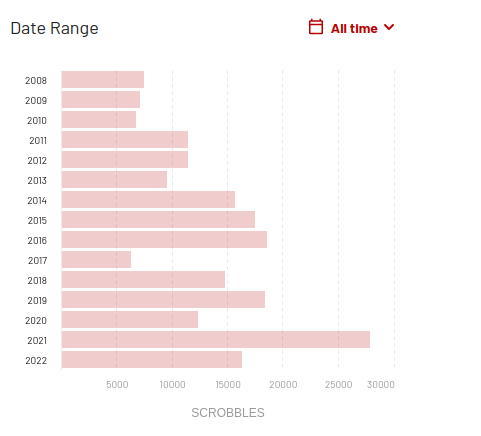In December 2022, after having scrobbled all my music plays made since January 2008 to Last.fm, I deleted my Last.fm account. Whilst Last.fm was a reasonable way to keep track of my listening history over time -and thus to spot patterns, gaps and over-playing as it happened- it is quite fundamentally flawed for classical music listeners. It records each track as it completes, for example, not when an entire composition finishes. It sees a four-movement symphony as, therefore, four separate 'things'. Similarly, if you play a Handel oratorio comprised of 90+ tracks, that single composition is recorded as 90 separate plays. The statistics are therefore usually massively over-stated. The fact that Last.fm is notorious in listing the same composer with 57 different spelling variations is also a bit of a problem!
Thus, I stopped "scrobbling" (that is, recording each completion of a 'play') to Last.fm in early November 2022 and deleted my account a month later.
But I wasn't going to lose all the data collected over the previous 14 years, even if it wasn't in a terribly good state. I was able to take a backup of it before the account was deleted, and I set to work knocking it into the sort of shape my Giocoso player would have stored, if I'd been using it 14 years ago! This is, inevitably, a bit of a bodge-job. 🙂 First, I had to take per-track data and try and knock it into per-composition data. Thus, where Last.fm lists four movements of a symphony, I needed to aggregate those four data records into a single row of data that indicated the playing of a single composition. The 202,000+ Last.fm records thus became records of me having played some 28,000 whole-compositions in the past 14 years or so.
By way of comparison, these are Last.fm's own figures for 'number of plays each year':
The absolutely numbers are completely different (in 2020, for example, Last.fm has 12,379 plays; I have 2,056). That's again because Last.fm was recording the playing of about 6 separate tracks per composition, on average. The overall shape of the graphs are not terribly different, however. Both sets of data show a plunge in plays during 2017, for example, compared to the year either side of it. That's pretty accurate, because that was the year I migrated back from Australia and spent six months renovating the house I'd bought in Nottingham: there's not a lot of point trying to listen to music when the builders are jack-hammering the plaster off the walls for weeks on end! The low numbers in 2008, 2009 and so on are also reflected appropriately in both sets of data: I hadn't yet committed to scrobbling my music plays, despite having created a new Last.fm account, and it took me a while to warm up to the idea!
Anyway: my point is that though the data port from Last.fm to this website involved one hell of a lot of data 'mangling', to record things in a classical-music-appropriate way, the overall shape of the graphs remain reasonably congruent, indicating that not too much data was ruined in the transport! As a result, I've felt it appropriate to include the historical numbers in with the 'count of plays per year' graph over in the live music statistics graphs page. I haven't felt confident enough in the data quality to load per-composer data into this site's records, however: thus, any given composer's list of past plays will not show anything happening before January 9th 2021 (when Giocoso and its immediate precursor player started to be used).
In 2021, of course, I wrote first AMP and then, from June onwards, Giocoso. All my music plays from that time forward have been recorded more accurately and appropriately, thanks to Giocoso's innate abilities to understand the concept of a composition, rather than a 'track'. The statistics from 2021 are therefore spot-on, not bodged into shape 🙂
